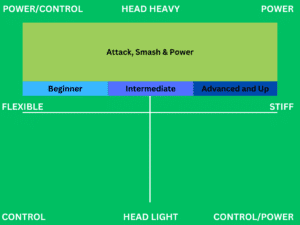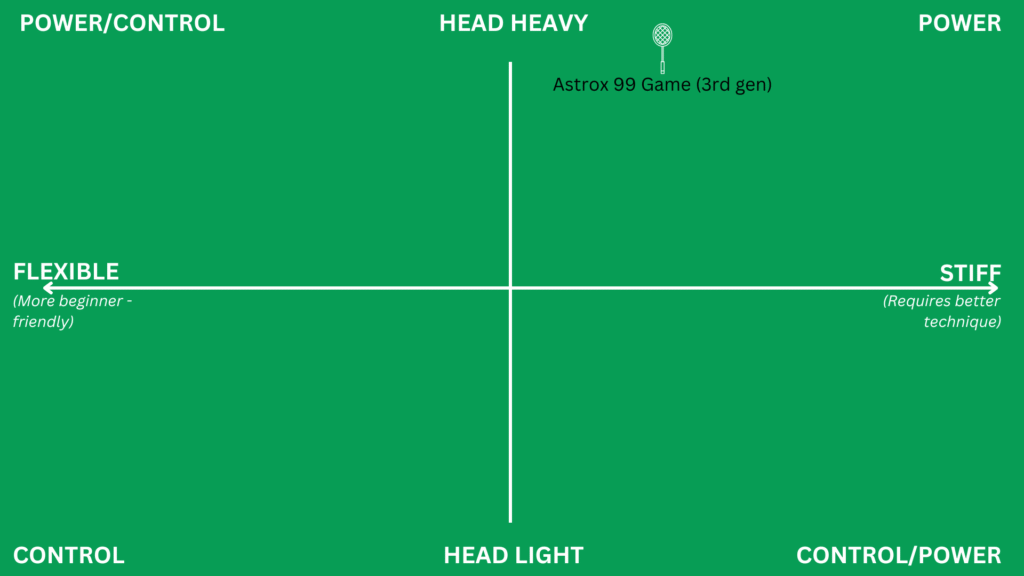THIS GUIDE HAS RECEIVED 7 UPDATES. THE LAST WAS MADE ON 29TH SEPTEMBER, 2025
- I've updated the intermediate racket recommendations based on a new test
They say that the first time you see a professional badminton tournament in person, you’ll be shocked at how powerful the smash sounds.
Heck, even if you’re a beginner, I bet you experienced the joy of hitting a hammer-slammer. One where even you are surprised by the speed as it catches your opponents off guard. When I do, I get an urge to find the best badminton rackets for smashing and smash over and over again.
The problem for many of us power lovers is that our technique isn’t amazing, so those hits become few and far between. Fortunately, we can get help by using the right racket.
Traditionally, it’s been easiest with rackets that carry more weight around the head (near the strings) than in the handle, as the swing can produce more power and momentum.
If we were to only look at raw power in a vacuum, the classic Yonex Voltric Z Force II, used by both Lee Chong Wei and Lin Dan, would probably take the cake.
On the other hand, that raw power typically means it’s hard to control nimble net play and fast defense. Players also tend to get shoulder fatigue as these rackets have a heavy swing due to the weight placement.
That means that the best rackets for smashing aren’t only based on raw power but also things like how easy it is for you to smash if you’re not in the perfect position, as it rarely happens that our opponents offer us the perfect setup for a smash over and over again.
In fact, in singles games against the right opponent, you might get away with only smashing, but it’s usually trickier in doubles games as you’ll also cover the front court at times.
You might find that for singles smashing, you’ll prefer the heavier 3U weight class, whereas 4U tends to fit doubles better as the gameplay is faster.
The best badminton rackets for smashing by skill level
For each racket, I’ll be looking at a matrix blending the flexibility and power to give you a sense of how the rackets compare to each other.
I’ve made this simple explainer to give you a sense of where you fall if you’re interested in attacking and smashing-based rackets, along with where each player level will fall in terms of flexibility. It isn’t perfect, but it’ll give you a rule of thumb to get started with.

With that out of the way, let’s look at some rackets!
Hey reader, a quick interruption...
I’m experimenting partnering with webshops that sell badminton gear, like Amazon. I’ll include links to buy the gear I review and if you do, they’ll pay me a small commission. That doesn’t change your price and you’ll get more play-tested gear as a result but I thought it was fair to let you know.
As an Amazon Associate, I earn from qualifying purchases.
I appreciate your support,
Aske
The best badminton rackets for smashing for beginners
1. The beginner power puncher: Yonex Astrox 88 Play (~$55-$75 on Amazon)
The best badminton rackets for smashing intermediate players
2. The intermediate Axelsen racket: Yonex Astrox 100 Game (~$125-$160 on Amazon)
3. The ALL-IN power racket: Yonex Astrox 99 Game (3rd gen, 2025) (~$125-$160 on Amazon)
Table of Contents

The two best badminton rackets for smashing beginners
First, let’s look at rackets for beginner players, where all the fun is in getting the shuttle back over the net and landing some powerful shots.
1. The power puncher: Yonex Astrox 88 Play

Pros
- Plenty of power, even in defense
- More suitable around the net than other power rackets for players without loads of training
Cons
- The extra head weight can still feel slow on gentle shots around the net
When it comes to raw, unfiltered power, the Astrox 99 Play is the king of the hill. This racket is like a sledgehammer… perfect for sending the shuttlecock into orbit.
But here’s the kicker: its stiffer shaft means it’s better suited for experienced beginners who’ve got a decent swing. If you’re brand new to the game and still figuring out which end of the racket to hold, this beast might feel like overkill.
It’s powerful, sure, but it demands a bit of finesse to tame. So, unless you’re ready to step up your game from day one, you might want to save this one for later. You can find my experience testing the Astrox 99 Play here.
The newer kid on the block, the Yonex Astrox 88 Play, is the real star for beginners chasing smash and power.
It’s still got plenty of power—think of it as a trusty pickup truck rather than a monster truck. It delivers a satisfying smash without making your shoulders feel like they’ve gone ten rounds in a boxing ring. That’s a big win if you’re the type who loves to hammer the shuttle every chance you get.
The slightly more flexible shaft means it’s easier to hit your shots cleanly on the sweet spot. You won’t feel like you’re swinging a brick when you’re trying to finesse a drop shot or defend a tricky return.
Plus, it’s forgiving enough for players still working on their technique, which is most of us at the beginner stage… right?
If you want more details, head over to my Yonex Astrox 88 Play review here.
The two best badminton rackets for smashing intermediate players
Next, let’s look at great rackets for smashing for intermediate players who’ve got more control over their game and are looking to hone in on their smash.
2. The intermediate Axelsen racket: Yonex Astrox 100 Game

Pros
- Generating power is damn easy
- If you’re tired or late to the shuttle, this racket can still make the game fun as it’ll help you push the shuttle over the net with ease
Cons
- Net play can be challenging to control
- It can often feel as if you’re focusing on managing all this power rather than extracting it, which can be tricky on i.e. the return of serve in doubles
Yonex’s Astrox 100 Game is the intermediate player’s version of Viktor Axelsen’s Astrox 100ZZ, and it packs SO much power. You can find my review of play-testing it here but to give you the recap, it was easy to get the shuttle back over the net even when I was late and out of position. It often felt like I just had to put the racket on the shuttle, and it would sail over the net.
On the other hand, net play was tricky as it was easy to give the shuttle too much power and let it bunch over the net in an arc that would give the opponent more time to react rather than just crawl over smoothly.
That same ability makes it a dream to block smashes though, as it’s often just about getting your racket on the shuttle for it to bounce back over the net nicely.
Speaking of smashing, as you’d expect this is a powerhouse. I’m not a particularly skilled player but even so, several of my doubles partners commented on the power I was able to generate with this racket.
If your opponents do not learn their lesson and stop lifting to you, it’s all about playing whack-a-mole and hammering the shuttle in the floor. If they do, it becomes a game of controlling all this power you have available rather than enabling it.
3. The ALL-IN power racket: Yonex Astrox 99 Game (3rd gen, 2025)

Pros
- LOTS of power, even in defense
- Great workout
Cons
- Fatiguing to play with
- Doubles drive duels and quick grip change is harder
The new 3rd generation of the Yonex Astrox 99-series was released recently, and I’ve had the privilege of testing the Game edition for intermediate players.
This is the most head heavy series in Yonex’s current catalog, so it’s hard not to include it on a list of the best badminton rackets for smashing.
The Astrox 99 Game 3rd generation is a beast of a racket with full focus on power, meaning it’ll typically be preferred for singles games. Overhead shots are fun and easy, even without a big swing.
On the other hand, things get trickier in doubles games, where things move faster. I struggled with soft shots and drive duels that require quick grip changes. I also found it super fatiguing to play with, especially towards the end of longer sessions on court.
If you’re looking for a good workout, this racket is great for that purpose. You can read my in-depth review of the Astrox 99 Game (3rd gen) here.
There are also the Play racket for beginners, along with the Tour and Pro options for more advanced players, but I haven’t tested these models. They go in the same direction, but differ in price and shaft stiffness.
Takeaways
- When it comes to the best badminton racket for smashing, the racket isn’t everything but it goes a long way besides technique and being positioned right
- There’s a meaningful difference between smashing rackets for singles and doubles games as doubles tend to require more speed and have fewer points won directly on a single smash